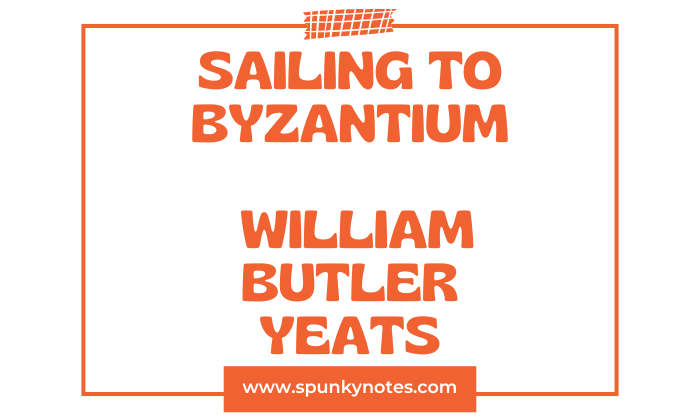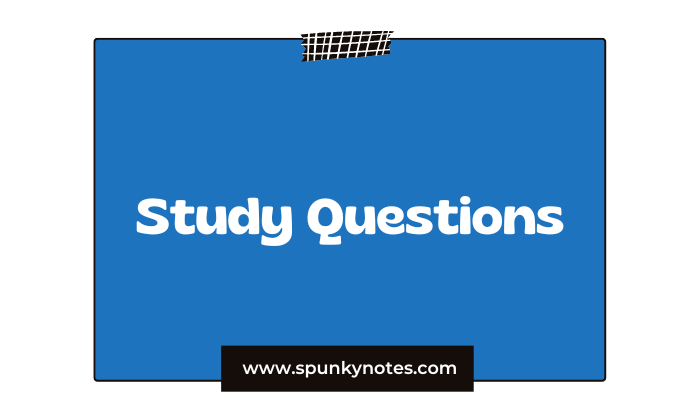
Q. Critically analyse Sailing to Byzantium by William Butler Yeats.
Sailing to Byzantium is a poem by W.B. Yeats, first published in 1928 in his collection “The Tower.” It contrasts the physical world with the idea of a spiritual or eternal world.
Analysis of Sailing to Byzantium
Stanza 1
That is no country for old men. The young
In one another’s arms, birds in the trees,
—Those dying generations—at their song,
The salmon-falls, the mackerel-crowded seas,
Fish, flesh, or fowl, commend all summer long
Whatever is begotten, born, and dies.
Caught in that sensual music all neglect
Monuments of unageing intellect.
That is no country for old men.
This line introduces the poem’s central theme. The speaker feels out of place in a world that is about young life’s physical and sensual aspects.
The country mentioned symbolizes a society where old age is neither valued nor respected, making it inhospitable for those who are old.
The young
In one another’s arms, birds in the trees,
—Those dying generations—at their song,
These lines depict a vibrant, life-filled setting where the young and nature are caught up in a beautiful, ephemeral life cycle.
The imagery of young people embracing, birds singing, and the reference to “dying generations” highlight the transient nature of life. This shows that each moment of beauty is fleeting and is inevitably followed by decay and death.
The salmon-falls, the mackerel-crowded seas,
Fish, flesh, or fowl, commend all summer long
Whatever is begotten, born, and dies.
These lines further develop the theme of the cyclical nature of life. It focuses on abundance and procreation in the natural world. Everything that lives (“Fish, flesh, or fowl”) shows this continuous and unending cycle.
Caught in that sensual music all neglect
In this line, the phrase “sensual music” represents the allure and pleasures of youth. The word “sensual” suggests a strong connection to the senses and emotions.
The word “all” implies that everyone, particularly the young, is captivated by this “sensual music.” It signifies that the youth are deeply engrossed in life’s physical and emotional aspects.
The word “neglect” conveys that the young are immersed in the sensations and passions of life and may overlook the deeper, intellectual, or spiritual aspects of existence.
This neglect is a source of concern for the speaker, as it suggests that pursuing physical pleasures may overshadow pursuing higher knowledge.
Monuments of unageing intellect.
In this line, “Monuments” refers to lasting and significant works, creations, or achievements. These are not physical structures but symbolic representations of human intellect and creativity.
The term “unageing” emphasizes that these monuments do not deteriorate or diminish with time; they remain eternal and unchanging.
The word “intellect” in this context signifies thought, knowledge, and intellectual pursuits. It is the highest expression of human wisdom, philosophy, and art.
Yeats suggests that these intellectual achievements are timeless and immune to the effects of ageing.
The line “Monuments of unageing intellect” implies that while physical bodies age and eventually decay, the creations of the mind, such as great works of literature, art, philosophy, and science, can transcend the limitations of mortality.
These intellectual monuments have the power to inspire, educate, and move generations long after their creators have passed away.
Stanza 2
An aged man is but a paltry thing,
A tattered coat upon a stick, unless
Soul clap its hands and sing, and louder sing
For every tatter in its mortal dress,
Nor is there singing school but studying
Monuments of its own magnificence;
And therefore I have sailed the seas and come
To the holy city of Byzantium.
An aged man is but a paltry thing,
The speaker begins by expressing a bleak view of old age in this line.
“An aged man” refers to an older person, and “paltry thing” suggests a sense of insignificance or frailty associated with aging.
It reflects the physical and societal limitations that come with old age.
A tattered coat upon a stick, unless
“Tattered coat upon a stick” is a metaphor for the frail and worn-out physical body of an older person. The word “unless” implies that something more profound is needed to give meaning to old age.
Soul clap its hands and sing, and louder sing
This line introduces the idea that the soul’s vitality can transform the experience of old age. When the soul is vibrant and expressive, it can elevate the individual’s existence.
“Clap its hands and sing” represents the soul’s capacity for joy, creativity, and spiritual fulfillment.
For every tatter in its mortal dress,
The soul’s singing and rejoicing become more intense in response to the physical “tatters” or imperfections in the mortal body.
It suggests that life’s challenges and hardships can catalyze the soul to sing more loudly and passionately.
Nor is there singing school but studying
This line emphasizes that the art of singing or expressing the soul’s vitality is not learned in a conventional “singing school.” Instead, it is cultivated by studying and contemplating profound and enduring creations.
Monuments of its own magnificence
The “monuments” here refer to the works of art, knowledge, or intellectual achievements that transcend time.
The soul learns and draws inspiration from these monuments, representing the highest expressions of human creativity and intellect.
And therefore I have sailed the seas and come
The speaker explains that they have embarked on a journey, symbolized by sailing the seas, to seek a place where the soul can thrive and be free from the physical body’s limitations.
To the holy city of Byzantium.
The destination of this journey is the “holy city of Byzantium.”
In this context, Byzantium is an imaginary land of timeless art and intellect, a place where the soul can find immortality and meaning beyond the physical world.
Stanza 3
O sages standing in God’s holy fire
As in the gold mosaic of a wall,
Come from the holy fire, perne in a gyre,
And be the singing-masters of my soul.
Consume my heart away; sick with desire
And fastened to a dying animal
It knows not what it is; and gather me
Into the artifice of eternity
O sages standing in God’s holy fire
The speaker invokes sages, wise and spiritually enlightened individuals, who are standing in the presence of divine knowledge and enlightenment.
They are metaphorically described as “in God’s holy fire,” signifying their proximity to spiritual truth and illumination.
As in the gold mosaic of a wall,
The sages are further likened to the intricate and radiant patterns of a “gold mosaic” adorning a wall. This imagery emphasizes their spiritual richness and luminosity.
Come from the holy fire, perne in a gyre,
The speaker implores the sages to descend from their spiritual enlightenment and engage with him.
The word “perne” in the phrase “perne in a gyre” from W.B. Yeats’ poem “Sailing to Byzantium” is an archaic and poetic term that means to revolve or spin.
In the poem’s context, “perne in a gyre” is a metaphorical expression suggesting a continuous, purposeful, circular motion or movement.
It conveys the idea of transformation and change, as if the sages are being called upon to descend from their spiritual state and engage in a transformative journey.
“Perne in a gyre” suggests a circular or spiralling movement, indicating a transformative process. The sages are asked to enter into the speaker’s life and consciousness.
And be the singing-masters of my soul.
The speaker desires the sages to guide and instruct his soul in the art of singing, not just in a literal sense but also metaphorically, as singing represents the expression of the soul’s vitality and creativity.
Consume my heart away; sick with desire
Here, the speaker expresses a yearning for his heart to be consumed by the sages’ wisdom and spiritual fire. His heart is described as “sick with desire,” indicating a deep longing for spiritual fulfillment.
And fastened to a dying animal
The speaker acknowledges the human condition, where the soul is “fastened” or attached to a mortal body, described as a “dying animal.” This physical existence is transitory and limited.
The term “dying animal” metaphorically represents the human body, which, like all living creatures, has a finite lifespan and eventually succumbs to death.
The use of the word “fastened” suggests that the soul is somehow attached or connected to the physical body during one’s earthly life.
It knows not what it is; and gather me
The speaker’s soul is portrayed as not fully comprehending its nature or purpose. He implores the sages to “gather” or elevate him beyond this ignorance and physicality.
Into the artifice of eternity
The speaker’s ultimate desire is to be transformed into a state of eternity, transcending the constraints of time and physicality.
“Artifice” suggests a deliberate and creative process of achieving this timeless state.
Stanza 4
Once out of nature I shall never take
My bodily form from any natural thing,
But such a form as Grecian goldsmiths make
Of hammered gold and gold enamelling
To keep a drowsy Emperor awake;
Or set upon a golden bough to sing
To lords and ladies of Byzantium
Of what is past, or passing, or to come.
Once out of nature I shall never take
The speaker begins by expressing their determination to transcend the realm of nature. The phrase “out of nature” implies a state of existence that is beyond or outside the realm of the physical and natural world.
The speaker desires to escape the constraints of mortality and ageing that are inherent to the natural world.
My bodily form from any natural thing,
The speaker emphasizes that they will never again assume a physical form derived from or connected to any aspect of the natural world.
This reflects the desire to escape the limitations of the physical body.
But such a form as Grecian goldsmiths make
Here, the speaker envisions a new form that is not of natural origin but is instead crafted by skilled Grecian goldsmiths.
This form represents a work of art and craftsmanship, symbolizing the transformation from the natural to the artistic.
Of hammered gold and gold enamelling
The envisioned form is “hammered gold” and adorned with “gold enamelling,” emphasizing its exquisite and precious nature.
The use of “gold enamelling” symbolizes the idea of transformation and elevation from the natural and mortal state to something more refined and beautiful.
Enamelling involves adding a layer of vibrant and enduring material (enamel) to an underlying base (gold), enhancing its appearance and durability.
Gold is already associated with beauty and preciousness; adding enamel enhances its aesthetic appeal.
To keep a drowsy Emperor awake;
The speaker imagines this new form as something that can captivate and engage even a drowsy Emperor, highlighting its beauty and captivating qualities.
The form, adorned with “gold enamelling” and possessing an exquisite beauty, has the power to awaken or invigorate even a drowsy Emperor.
This awakening is not necessarily physical but rather a metaphorical awakening of the Emperor’s senses, emotions, or creative spirit.
Or set upon a golden bough to sing
The envisioned form could also be placed on a “golden bough” to sing or create music. This further emphasizes the idea of transcendence through art and creativity.
To lords and ladies of Byzantium
The speaker envisions presenting this new form to the aristocracy and nobility of Byzantium, suggesting that it represents a higher and more refined level of existence.
Of what is past, or passing, or to come.
The new form, in its timeless and artistic nature, can convey knowledge and wisdom about the past, present, and future.
It represents a state of being that transcends the limitations of time and the transience of the natural world.

